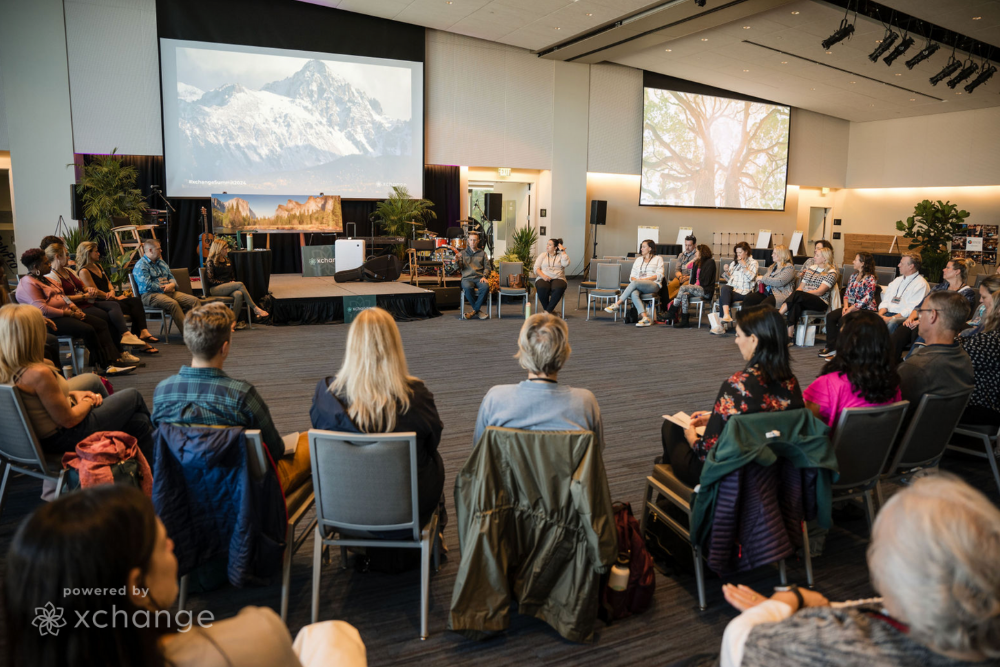GRab your free copy of the 7 Essential Traits of high achieving women

Building Connection in Leadership Conversations: An Approach to Impactful Communication
Filed in Work is Life — April 29, 2025
I’ve been coaching people to be their best for over twenty years and love seeing them thrive as they adjust the lens they’re looking through. As a mom of teengaers, I realized that I could use my talent to help moms feel less frustrated, isolated and defeated as their kids navigate the challenging teen years. Helping my clients improve their relationship with themselves and honor their needs is my superpower. You’ll love how your energy shifts and your interactions become more positive after working together! I’m excited for you to experience more peace and confidence and live the life you’re meant to live.
Building connection in leadership conversations and team meetings has been a focus throughout my career. I’ve seen firsthand how connection is not only at the core of effective leadership communication, but by being the example, you can encourage connection across any group. Recently I obtained a formal certification in the xChange approach that multiplies the impact I’ve been having with my clients and in my own personal life. It’s a practice so simple in nature, yet incredibly transformative. It opens up rooms to real connection and impact so I wanted to share examples and tips with you.
In this post, I’ll share what I’ve found works for fostering connection in team meetings and embracing vulnerability in leadership communication and within families, drawing from my years of practice. With data-driven insights, practical strategies, and a personal story about staying connected with my children during major life changes, I hope to inspire you to transform your own conversations.
The Power of Connection in Leadership
A 2023 Gallup study found that organizations with highly engaged employees – often driven by connected leaders – see 23% higher profitability and 66% lower absenteeism (Gallup, 2023). Yet, only 15% of employees globally feel engaged, signaling a gap in authentic leadership interactions. In my practice, I’ve seen that building connection in leadership conversations creates trust, sparks collaboration, and drives results.
Connection isn’t just about words; it’s about fostering a shared purpose. Whether leading a one-on-one discussion or a team meeting, I’ve found that intentional practices, rooted in empathy and active listening, turn routine interactions into moments of impact. Let’s explore how these principles come to life in team settings and through vulnerable leadership.

Building Connection in Leadership Conversations: Peer-to-Peer
Communication among leader peers in meetings or planning activities can be challenging, especially when competing priorities or egos arise. I’ve found that appreciative inquiry, a method that focuses on strengths and positive possibilities, transforms these interactions. By asking questions that highlight what’s working and envisioning bold futures, peers build connection and align on shared goals.
Consider a strategic planning session with department heads. Tensions run high as budgets are debated. Instead of letting the discussion devolve, one leader uses an appreciative inquiry approach, asking, “What’s been our team’s greatest success this year, and how can we build on it?” This question shifts the focus to shared wins, like a recent product launch. Peers share stories, listen actively, and summarize each other’s points, for example “It sounds like our cross-department collaboration was key.” This fosters mutual respect, aligning the group on a budget that leverages past strengths. A 2022 McKinsey study shows that collaborative leadership teams are 25% more likely to achieve strategic goals (McKinsey & Company, 2022).
Another example is a peer-to-peer meeting to resolve a conflict over resource allocation. Rather than arguing, a leader asks, “What’s one thing we’ve each done well in resource management, and how can we apply that here?” This appreciative inquiry prompt encourages peers to acknowledge strengths—e.g., one’s data-driven approach, another’s team engagement. By reflecting back, like, “I hear your focus on analytics really streamlined costs,” they build connection in leadership conversations. The Center for Creative Leadership (2023) notes that high-trust leadership teams are 50% more productive (Center for Creative Leadership, 2023). These peer interactions show how appreciative inquiry fosters connection and collaboration.
Fostering Connection in Team Meetings
Team meetings can be powerful for fostering connection, but too often, they feel unproductive. A 2024 Harvard Business Review article revealed that 70% of employees find meetings ineffective, often due to a lack of psychological safety (Harvard Business Review, 2024). In my work with teams, I’ve found that creating inclusive spaces where everyone feels valued transforms these gatherings.
Picture a project manager leading a hybrid team meeting. Instead of jumping into tasks, they ask, “What’s one thing you’re excited about this week, personally or professionally?” This simple question, drawn from my coaching approach, invites authentic sharing, fostering connection in team meetings. By listening actively and perhaps paraphrasing a response like, “It sounds like that client win was a big moment for you,” the manager shows genuine interest. Research from McKinsey & Company (2022) shows that inclusive meetings boost team innovation by up to 20% (McKinsey & Company, 2022).
When conflict arises, a leader might say, “I hear you’re frustrated about the timeline—can you share more?” This reflective listening de-escalates tension and builds trust, creating an environment where diverse ideas thrive. By fostering connection in team meetings, leaders unlock team potential.

Vulnerability in Leadership Communication
Embracing vulnerability in leadership communication is transformative, though many leaders fear it signals weakness. A 2023 Korn Ferry Institute study found that 72% of employees trust and follow leaders who show vulnerability, as it makes them relatable (Korn Ferry, 2023). In my practice, I’ve seen vulnerability act as a bridge to deeper connections, strengthening teams and relationships.
Picture a leader addressing peers during a tough quarter. Instead of projecting confidence, they say, “I’m concerned about our metrics, and I’d value your perspectives.” This openness invites collaboration, strengthening peer bonds. Edelman’s 2024 Trust Barometer shows that transparent leadership boosts employee loyalty by 30% (Edelman, 2024). Vulnerability in leadership communication builds trust that fuels resilience.
Another example is a manager mentoring a team member struggling with performance. Instead of generic advice, they share, “Early in my career, I botched a major presentation and felt defeated. Breaking tasks into smaller steps helped—how can I support you?” This vulnerability, a tactic I’ve found effective, creates a safe space for honest dialogue. What I’ve learned is that vulnerability isn’t a risk; it’s a strength that deepens relationships and drives growth.
A Personal Story: Staying Connected with My Kids Across Continents
The principles I use in leadership also transform personal connections, especially with my children. As my kids moved out to college and on with their new adult lives, I relocated to Spain. Maintaining our bond was incredibly important to me and I didn’t want them to feel abandoned. Distance, time zones, and new routines could have strained our relationship, but what I’ve found through intentional practices has kept us close.
I began scheduling regular video calls, but rather than surface-level chats, I asked questions like, “What’s been the toughest part of your week?” or “What’s something you’re really proud of?” These open-ended prompts led to deeper conversations. For example, my son acknowledged that finding his first “real” job was harder than he thought. Instead of telling him what he should do I responded, “I know it’s not the same as when I was in your shoes. What’s been working?” This reflective listening opened the door to meaningful support, strengthening our connection.
When I moved to Spain, I worried the distance would create a gap. So, I leaned into vulnerability, saying, “I’m thrilled about this new chapter, but I’m nervous about being so far from you both.” This honesty prompted my son to open up about the details of his freshman year, the good and the tough. Together, we created rituals that we can rely on. These small acts, rooted in my practice of empathy and connection, keep our relationships vibrant. Despite the miles, we’re closer than ever, showing that connection transcends physical boundaries.
Practical Strategies for Connected Conversations
To help you build connection in leadership conversations, foster connection in team meetings, and embrace vulnerability in leadership communication, here are five strategies I’ve found effective:
- Ask Open-Ended Questions: Start meetings or one-on-ones with prompts like, “What’s on your mind today?” to encourage authentic sharing and set a connected tone.
- Listen Actively: Show engagement by paraphrasing, e.g., “It sounds like you’re concerned about X. Am I getting that right?” This builds trust and clarity.
- Be Vulnerable: Share a challenge, like, “I’m unsure about this approach. What do you think?” This invites others to open up and collaborate.
- Promote Inclusivity: In meetings, ensure everyone is invited to contribute by asking, “Who else has something to share?” Responding positively, regardless of whether you agree or not, fosters connection by valuing all perspectives. This could be something like, “I’m glad you felt comfortable bring that up. Do you have any ideas on how to address it?”
- Follow Up Thoughtfully: After a conversation, send a note like, “Thanks for sharing. I’m here if you want to discuss more.” This reinforces connection over time.
These strategies are straightforward but powerful. A 2024 LinkedIn study found that 80% of employees value leaders who prioritize relationships, leading to 25% higher retention (LinkedIn, 2024). In my work, I’ve seen these practices create immediate shifts in engagement and trust.
The Ripple Effect of Connected Leadership
What I’ve found is that building connection in leadership conversations and fostering connection in team meetings transforms how we lead and relate. Embracing vulnerability in leadership communication unlocks trust, collaboration, and innovation. The data backs this up: connected leaders drive engagement and loyalty, while connected individuals build stronger personal bonds. Whether you’re rallying a team, coaching an employee, or connecting with family across continents, these principles create lasting impact.
Try one strategy in your next conversation and notice the difference. As I’ve seen with my clients and my own family, small acts of connection turn ordinary interactions into extraordinary moments. Ready to elevate your leadership and relationships? Start with connection, and let every conversation spark meaningful change.
Curious why your leadership events might be missing the mark? Grab my free guide today.
My FREE Feed Your Soul guide will help you reinvigorate so you can start feeling like yourself again.
Feel like you’ve lost control of your physical and emotional energy?
I’ve been coaching people to be their best for over twenty years and love seeing them thrive as they adjust the lens they’re looking through. As a mom of teengaers, I realized that I could use my talent to help moms feel less frustrated, isolated and defeated as their kids navigate the challenging teen years. Helping my clients improve their relationship with themselves and honor their needs is my superpower. You’ll love how your energy shifts and your interactions become more positive after working together! I’m excited for you to experience more peace and confidence and live the life you’re meant to live.